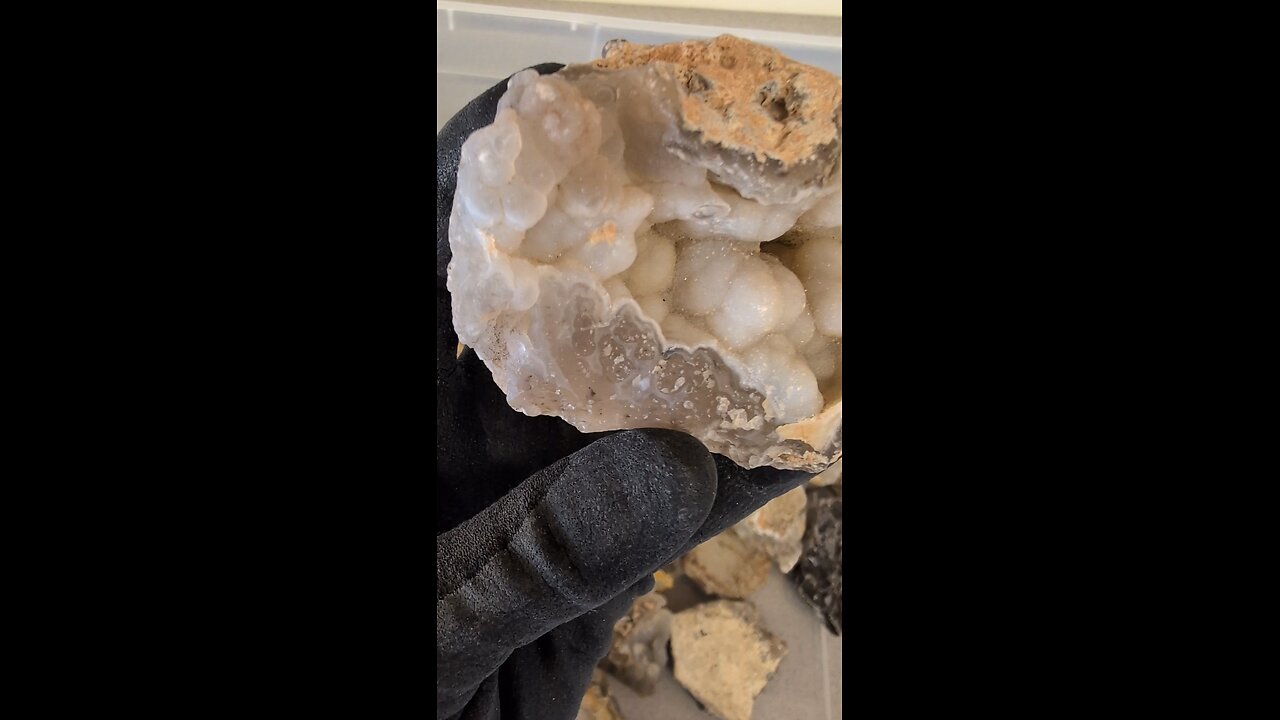Premium Only Content

Botryoidal Geode!
This rock appears to be a geode filled with chalcedony or agate. Here's a detailed explanation:
Geode: Geodes are hollow, vaguely spherical rocks, often formed in volcanic and sedimentary rocks. They have a thin outer layer and are typically lined with crystals inside. The one in the image has been cut open to reveal its interior.
Chalcedony: This is a cryptocrystalline form of silica, composed of very fine intergrowths of quartz and moganite. Chalcedony can appear in various colors and forms, including agate, which has banding or layers.
Agate: If the chalcedony within the geode shows banding or layers, it could be classified as agate. Agate typically has more distinct color bands, which might not be very clear in this specimen due to the type of formation or the cut.
Formation: Geodes form when gas bubbles or volcanic cavities get filled with mineral-rich water. Over time, the minerals precipitate out of the water, forming layers or crystals inside the cavity. In this case, the minerals appear to have formed botryoidal (grape-like) structures, which is common in chalcedony.
Appearance: The white to light gray, rounded, botryoidal formations inside the geode suggest chalcedony. The outer shell seems to be a mix of quartz and possibly some iron staining, giving it the brownish hues.
-
 LIVE
LIVE
Simply Bitcoin
1 hour agoDid America JUST Change The Bitcoin Nation State Race Forever?! | EP 1175
363 watching -
 37:13
37:13
Grant Stinchfield
1 hour agoBill Gates is Making the Media Rounds Today to Push the Vax and Stop RFK Jr.
851 -
 LIVE
LIVE
TheAlecLaceShow
2 hours agoGuest: Rep. Burgess Owens | Trump Wins with Mexico & Canada | DNC Diversity | The Alec Lace Show
187 watching -
 1:00:28
1:00:28
The Dan Bongino Show
3 hours agoTrump’s Most Important Fight To Date (Ep. 2415) - 02/04/2025
486K734 -
 59:44
59:44
The Rubin Report
2 hours agoPress Gasps When Shown What USAID Spent Money On
53.8K37 -
 LIVE
LIVE
Bare Knuckle Fighting Championship
3 hours agoThe Bare Knuckle Show with Brian Soscia
148 watching -
 LIVE
LIVE
The Shannon Joy Show
3 hours ago🔥SHOCK Report - The COVID Dossier! A Coordinated Global Military Operation: Live EXCLUSIVE W/ Sasha Latypova & Debbie Lerman.🔥
514 watching -
 1:57:04
1:57:04
Steven Crowder
4 hours agoUSAID Exposed: Everything You Need to Know Featuring Mike Benz
301K174 -
 2:01:57
2:01:57
LFA TV
17 hours agoCLEANING HOUSE!! | LIVE FROM AMERICA 2.4.25 11am
48.5K15 -
 DVR
DVR
Bannons War Room
1 year agoWarRoom Live
111M